Micro-ATX Cases - Shoebox Showdown
by Joshua Buss on January 2, 2007 12:40 PM EST- Posted in
- Cases/Cooling/PSUs
PC Design Lab Qmicra - Exterior
U.S. based PC Design Lab has only one case to their name so far, and its name is the Qmicra. The case, just like the company, is different from just about everything else out there. When talking to PC Design Lab, one this is for certain - this company is very serious about creating the highest quality product possible, period. Citing poor layout designs and sometimes downright shoddy workmanship as motivations for designing a better small form PC case, designer and company owner Dave LaLopa made it clear that the Qmicra does many things unconventionally in the interest of making a superior final product.
The Qmicra's construction is considerably different from pretty much anything else because its strength comes from the exoskeleton - not from any internal bracing. When fully assembled, one feels confident that the computer could take a serious amount of abuse without the internals suffering much damage. Entirely manufactured and assembled in the USA, the case is also a fine example of what high-quality craftsmanship entails.
As for the external styling of the case, the Qmicra understandably takes most of its cues from the currently popular minimalist philosophies. The front is just solid brushed aluminum with an eighth-inch thick sheet of Plexiglas in front for the glossy sheen and added protection. Two 5.25" and one 3.5" external bays offer the typical "upper limit" drive flexibility for this size system, and only the essential power and reset buttons are present. Even the almost-always-present front-mounted ports are missing, but the 3.5" bay would be perfect for those that feel they are absolutely critical. We were told that newer versions of the case will have nicer looking reset buttons that better match the theme and current power button (center). At the bottom of the front panel are two perforations for the front 80mm fan intakes.
Matching the two front intake positions are the two 80mm rear exhaust vents, allowing for a generous amount of airflow for any case in this class, especially taking into account the full-sized power supply as well. Notice how the mounting points for the power supply are perfectly symmetrical too, so there is no concern that flipping a PSU upside down will make it less stable. Instead of a recessed motherboard, the Qmicra positions the board as rearward as possible, with the expansion card mounting tabs actually sticking further beyond the rest of the rear of the case. The perfectly centered power supply mount makes the case not only look nice but also allows for the distinctive rounded top corners.
Together, the four thumbscrews pull the front and rear plates to just the right position using the two long aluminum rods. The five-sided, one-piece cover seals against the rest of the case thanks to a soft rubber strip and is held firmly in place by both the pressure from the rods and the four unique screw-in feet.
The fit and finish of the Qmicra is certainly as high-quality as any other case we've ever dealt with. Every part feels solid and well-made, and the fit of each part couldn't be better. The brushed aluminum finish itself is fantastic - it's not prone to fingerprints, yet it can still be cleaned easily if needed. It's anodized so it won't make things dirty by simply rubbing against them, and it's just thick enough to be strong without adding weight - an empty Qmicra is feather light. More information on the Qmicra is available on PCDL's website.
U.S. based PC Design Lab has only one case to their name so far, and its name is the Qmicra. The case, just like the company, is different from just about everything else out there. When talking to PC Design Lab, one this is for certain - this company is very serious about creating the highest quality product possible, period. Citing poor layout designs and sometimes downright shoddy workmanship as motivations for designing a better small form PC case, designer and company owner Dave LaLopa made it clear that the Qmicra does many things unconventionally in the interest of making a superior final product.
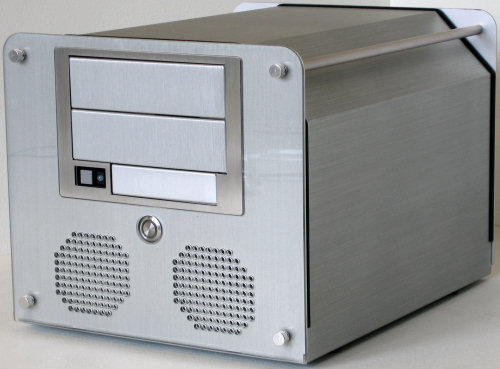 |
| Click to enlarge |
The Qmicra's construction is considerably different from pretty much anything else because its strength comes from the exoskeleton - not from any internal bracing. When fully assembled, one feels confident that the computer could take a serious amount of abuse without the internals suffering much damage. Entirely manufactured and assembled in the USA, the case is also a fine example of what high-quality craftsmanship entails.
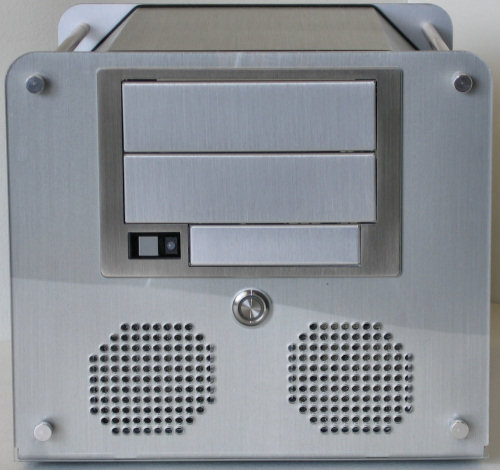 |
| Click to enlarge |
As for the external styling of the case, the Qmicra understandably takes most of its cues from the currently popular minimalist philosophies. The front is just solid brushed aluminum with an eighth-inch thick sheet of Plexiglas in front for the glossy sheen and added protection. Two 5.25" and one 3.5" external bays offer the typical "upper limit" drive flexibility for this size system, and only the essential power and reset buttons are present. Even the almost-always-present front-mounted ports are missing, but the 3.5" bay would be perfect for those that feel they are absolutely critical. We were told that newer versions of the case will have nicer looking reset buttons that better match the theme and current power button (center). At the bottom of the front panel are two perforations for the front 80mm fan intakes.
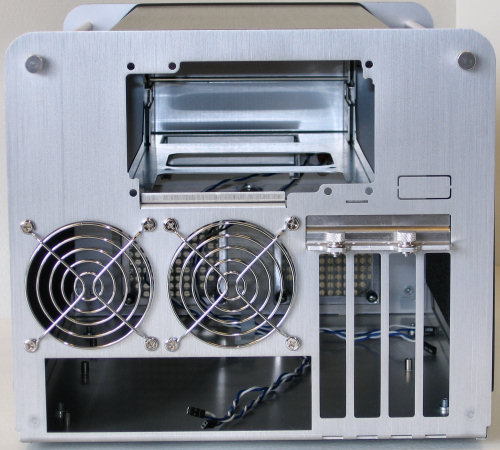 |
| Click to enlarge |
Matching the two front intake positions are the two 80mm rear exhaust vents, allowing for a generous amount of airflow for any case in this class, especially taking into account the full-sized power supply as well. Notice how the mounting points for the power supply are perfectly symmetrical too, so there is no concern that flipping a PSU upside down will make it less stable. Instead of a recessed motherboard, the Qmicra positions the board as rearward as possible, with the expansion card mounting tabs actually sticking further beyond the rest of the rear of the case. The perfectly centered power supply mount makes the case not only look nice but also allows for the distinctive rounded top corners.
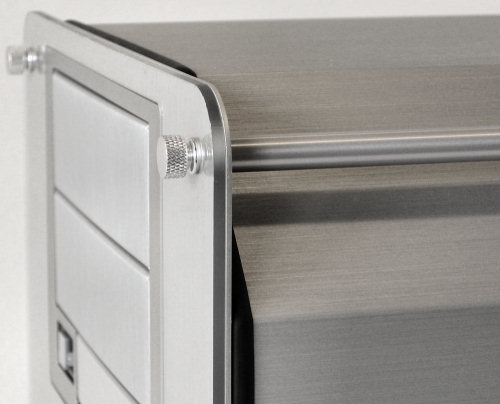 |
| Click to enlarge |
Together, the four thumbscrews pull the front and rear plates to just the right position using the two long aluminum rods. The five-sided, one-piece cover seals against the rest of the case thanks to a soft rubber strip and is held firmly in place by both the pressure from the rods and the four unique screw-in feet.
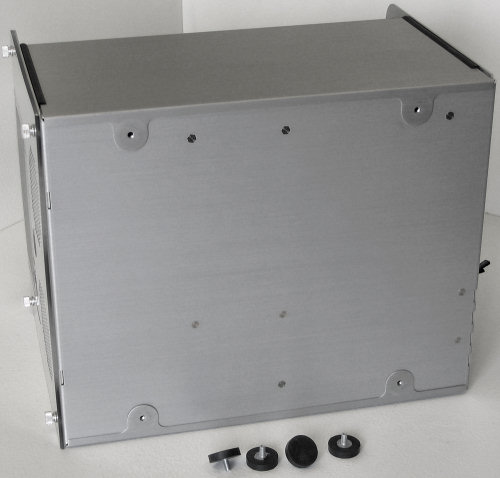 |
| Click to enlarge |
The fit and finish of the Qmicra is certainly as high-quality as any other case we've ever dealt with. Every part feels solid and well-made, and the fit of each part couldn't be better. The brushed aluminum finish itself is fantastic - it's not prone to fingerprints, yet it can still be cleaned easily if needed. It's anodized so it won't make things dirty by simply rubbing against them, and it's just thick enough to be strong without adding weight - an empty Qmicra is feather light. More information on the Qmicra is available on PCDL's website.










37 Comments
View All Comments
warthogism - Thursday, February 1, 2007 - link
I know that you guys were able to fit an CNPS7000 in there and that a 9000 would not fit. What I was wondering is if a CNPS7700 would fit. The difference is that the height of the 7000 is 62mm and the 7700 is 67mm. Also, the 7000 has a 92mm but the 7700 uses a 120mm fan. Does anyone have first-hand knowledge? or at least, does it look like the 7700 will fit? Thanks for the help.gool - Saturday, January 13, 2007 - link
I'm the happy owner of a heavily modded Antec Aria - blow holes, sidefans, PSU-fan replacement and so on. It's based on a MSI Micro-ATX 939 motherboard, AMD 64-3200 (Clawhammer), 1 GB DDR-SDRAM, Liteon DVD-CD combo, a 160GB 7200 Maxtor disc, an external (USB2) Maxtor 250 GB disc and a Nvidia 6600GT card. The latter is the one I wish to replace, but I'm uncertain if I'm able to draw enough juice from the standard Antec 300W psu for this purpose? Seen people with a similar setup who uses a 7800GT card without problem. What are you guys advice - could I go down this road?Cheers,
Svend
Patrese - Sunday, January 7, 2007 - link
Great review, but I'd like to see something about the new (and not no new) uATX motherboards on the market, specially the Asus M2NPV-VM and Abit NF-M2 NView...artifex - Thursday, January 4, 2007 - link
I suggest everyone interested in these smaller form factors to look at sfftech.com and mini-itx.com. Plenty of reviews and some nifty case mods, etc.mino - Thursday, January 4, 2007 - link
I like that you made semi-pro noise tests for the cases.However as changing noisy PSU/fan is the easiest thing to do(I have yet to us a case with included PSU/fan)..
It would be nice to complement out-of-the-box testing with controlled-enviroment testing.
It would be more informative, especially to enthusiasts, to make a reference rig (fans, PSU, all coolers, HDD) and assemble it into different cases.
To know that a case comes with a noisy PSU is nice. However to know its ability to dampen the brum of an HDD, or mute the pinch of a GPU cooler is far better.
Nice work otherwise, keep on.
JoshuaBuss - Thursday, January 4, 2007 - link
This is a very good idea, but to a certain extent we believe it's the manufacturer's responsibility to supply a case with fans that work best for its need, not the user's. At the least a manufacturer should offer recommended buys (like PDCL did) so that a user knows what should work well. If a fans that come with a regular case are so bad that it's truly hurting the overall appeal, we normally do try it with a different configuration to see if we can do better. With these micro ATX cases it's often the case that the included power supply is a custom fit and we have to test it 'as is'.Thanks for the suggestion.
mino - Thursday, January 4, 2007 - link
I suggest you take a look at the ASUS TM-21/23/25 series especially the TM-250.I have yet to see a case of this size with better internal organization, such a good cooling performance. As a bonus the case is very sturdy (especially for such a low weight product).
The ability to put 3 HDD's in a 15.6*6.7*14inch box _and_ cool them without additional fans speaks for itself.
Newegg lists them for $50 with 300W high-quality PSU's.
However we bought 100 a month ago in EU and they came with 350W and _without_ that annoying floppy hole...
mino - Thursday, January 4, 2007 - link
One little problem I missed, those on Newegg(provided they sell the exact model as on image) have ATX 1.3 PSU's.While these Bestec PSU units are pretty good - PFC, very quiet(have 20+ of them deployed) - 180W on 12V rail may not be sufficient for a gaming rig.
I hope the new refresh models(350W,no floppy), we bought recently, will hit the US market soon.
artifex - Thursday, January 4, 2007 - link
I'd like to see a review of the power supplies used in some of these, as well as third-party replacements. Heck, I'd even like to see a new version of the old ATX PS roundup/review Anandtech did years ago -- I bought my Antec TruePower 430 after that, and it's lasted through a second system, but I've no doubt it's getting creaky now.IronChefMoto - Wednesday, January 3, 2007 - link
First off, decent article. I would like to have seen Anandtech test different video cards in the cases, though. One of the issues with nice mATX cases like the Lian Li V300 (???) is that longer, high-level chipset cards like the 7900 series hit pieces of the framework in the case. You have to mod your case or your card for the Lian Li model.While folks won't always be dropping a 7950GT into one of these, having that option is nice if you want to build a small, high-end gaming rig. Please try and make that part of your mATX review setup in the future. I've even asked Newegg.com to start adding card length data to their specs (they're opening the cards anyway for product shots) so you don't end up having to send back a card that doesn't physically fit a case by 1/4".
That said, my friend and I built v1 Aria (when it had more front ports) about 2 years ago. It was the toughest build I've ever had to do. It was cramped, the PSU had to come out for assembly, and the CPU cooler was up next to the PSU. The temps idled 60C with a very hot P4 Prescott (???) CPU. My buddy upgraded the unit with a Zalman Reserator and continues to use it today running at about 35C under load.
I would recommend that anyone looking at an mATX case check to see that the PSU is STANDARD ATX or a replaceable mATX format. The v1 Aria will not accept an ATX replacement without some modification and/or loss of space. This holds true for mATX barebones like Shuttle XPCs (I own/am stuck with two (2)).
IronChefMorimoto